
Aktion T4 was a campaign of mass murder by involuntary euthanasia in Nazi Germany. The term was first used in post-war trials against doctors who had been involved in the killings. The name T4 is an abbreviation of Tiergartenstraße 4, a street address of the Chancellery department set up in early 1940, in the Berlin borough of Tiergarten, which recruited and paid personnel associated with Aktion T4. Certain German physicians were authorised to select patients "deemed incurably sick, after most critical medical examination" and then administer to them a "mercy death". In October 1939, Adolf Hitler signed a "euthanasia note", backdated to 1 September 1939, which authorised his physician Karl Brandt and Reichsleiter Philipp Bouhler to begin the killing.
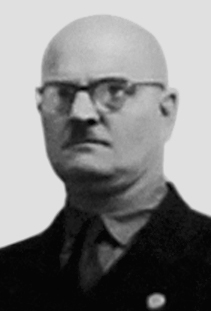
Christian Wirth was a German SS officer and leading Holocaust perpetrator who was one of the primary architects of the program to exterminate the Jewish people of Poland, known as Operation Reinhard. His nicknames included Christian the Cruel, Stuka, and The Wild Christian due to the extremity of his behaviour among the SS and Trawniki guards and to the camp inmates and victims.
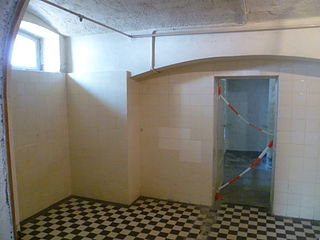
The Hadamar killing centre was a killing facility involved in the Nazi involuntary euthanasia programme known as Aktion T4. It was housed within a psychiatric hospital located in the German town of Hadamar, near Limburg in Hessen.
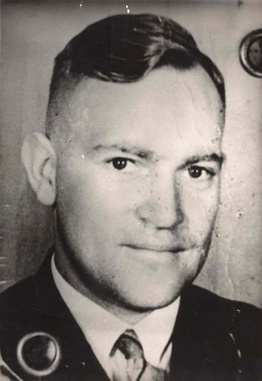
Horst Schumann was an SS-Sturmbannführer (major) and medical doctor who conducted sterilization and castration experiments at Auschwitz and was particularly interested in the mass sterilization of Jews by means of X-rays.

The social policies of eugenics in Nazi Germany were composed of various ideas about genetics. The racial ideology of Nazism placed the biological improvement of the German people by selective breeding of "Nordic" or "Aryan" traits at its center. These policies were used to justify the involuntary sterilization and mass-murder of those deemed "undesirable".
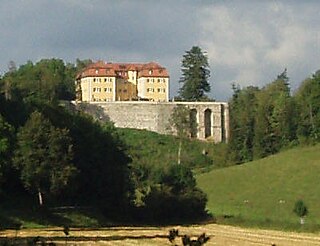
The Grafeneck Euthanasia Centre housed in Grafeneck Castle was one of Nazi Germany's killing centres as part of their forced euthanasia programme. Today, it is a memorial site dedicated to the victims of the state-authorised programme also referred to since as Action T4. At least 10,500 mentally and physically disabled people, predominantly from Bavaria and Baden-Württemberg, were systematically killed during 1940. It was one of the first places in Nazi Germany where people were killed in large numbers in a gas chamber using carbon monoxide. This was the beginning of the Euthanasia Programme. Grafeneck was also the central office of the "Charitable Ambulance Transport GmbH" (Gekrat), which was headed by Reinhold Vorberg and responsible for the transport of T4.
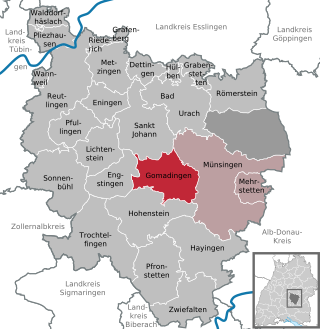
Gomadingen is a town in the district of Reutlingen in Baden-Württemberg in Germany. About 85% of its territory is located on the Swabian Alps. It's the district where the Grafeneck Castle is situated. During the II World War, the castle was home of the Grafeneck Euthanasia Centre, one of the main Nazi Germany's killing centres part of their Action T4 programme.

Heinrich Barbl was an Austrian-born SS-Rottenführer. He participated in the T-4 euthanasia program in Nazi Germany and, after the invasion of Poland, in Operation Reinhard phase of the Holocaust.
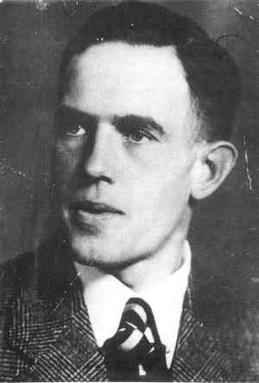
Lorenz Hackenholt was a member of the Schutzstaffel (SS) with the rank of Hauptscharführer. During World War II Hackenholt built and operated the gas chamber at the Bełżec extermination camp in occupied Poland during Operation Reinhard. In so doing, he personally carried out the murder of hundreds of thousands of people.

Erwin Hermann Lambert was a German perpetrator of the Holocaust. In profession, he was a master mason, building trades foreman, Nazi Party member and member of the Schutzstaffel with the rank of SS-Unterscharführer (corporal). He supervised construction of the gas chambers for the Action T4 euthanasia program at Hartheim, Sonnenstein, Bernburg and Hadamar, and then at Sobibór and Treblinka extermination camps during Operation Reinhard. He specialized in building larger gas chambers that killed more people than previous efforts in the extermination program.

Ernst Zierke was a low-ranking member in the SS who took part in the Aktion T4 forced euthanasia program in Nazi Germany, and after the invasion of Poland worked at Bełżec and Sobibór extermination camps during Operation Reinhard. Zierke helped to perpetrate the Holocaust. He was charged with being an accessory to the murder of 360,000 Jews at death camps, acquitted twice, in the Belzec and Sobibor trials of 1965 on grounds of acting under duress and set free.

Action 14f13, also called Sonderbehandlung14f13 and Aktion 14f13, was a campaign by Nazi Germany to murder Nazi concentration camp prisoners. As part of the campaign, also called invalid or prisoner euthanasia, the sick, the elderly and those prisoners who were no longer deemed fit for work were separated from the rest of the prisoners during a selection process, after which they were murdered. The Nazi campaign was in operation from 1941 to 1944 and later covered other groups of concentration camp prisoners.

The Gemeinnützige Krankentransport GmbH was a subdivision of the Action T4 organization. The euphemistically named company transported sick and disabled people to the Nazi killing centers to be murdered under the Nazi eugenics program and was known for the gray buses it used. The many victims were murdered in sealed gas chambers with carbon monoxide gas supplied in metal gas cylinders, and fed through false spray heads appearing to be shower heads. The programme Aktion T4 was managed by Viktor Brack, who was tried for his crimes at Nuremberg, and executed as a result. The operation was ordered by Adolf Hitler in early September 1939, and organized by Philip Bouhler and Karl Brandt of the Reich Chancellery.

The Sonnenstein Euthanasia Clinic was a Nazi killing centre located in the former fortress of Sonnenstein Castle near Pirna in eastern Germany, where a hospital had been established in 1811.

The Hartheim killing centre was a killing facility involved in the Nazi programme known as Aktion T4, in which German citizens deemed mentally or physically unfit were systematically murdered with poison gas. Often, these patients were transferred from other killing facilities such as the Am Spiegelgrund clinic in Vienna. This was initially a programme of "involuntary euthanasia" permitted under the law ostensibly to enable the lawful and painless killing of incurably ill patients; these murders continued even after the law was rescinded in 1942. Other victims included Jews, Communists and those considered undesirable by the state. Concentration camp inmates who were unfit for work, or otherwise deemed troublesome, were also executed here. The facility was housed in Hartheim Castle in the municipality of Alkoven, near Linz, Austria, which now is a memorial site and documentation centre.

August Wilhelm Miete was an SS functionary of Nazi Germany. He worked at the Grafeneck and Hadamar Euthanasia Centres, and then at Treblinka extermination camp. Miete was arrested in 1960 and tried in West Germany for participating in the mass murder of at least 300,000 people; in 1965, he was found guilty and sentenced to the maximum penalty, life imprisonment.

Albert Widmann was an SS officer and German chemist who worked for the Action T4 euthanasia program during the regime of Nazi Germany. He was convicted in two separate trials in the West German courts in the 1960s for his criminal activities during World War II.
Helmut Kallmeyer was a German chemist in the era of National Socialism. He served as a consultant in Adolf Hitler's Chancellery for gasification methods. Later, he worked in the Technical Institute for the Detection of Crime. He was involved in Action T4, Nazi Germany's program to murder people with disabilities.
Dasein ohne Leben – Psychiatrie und Menschlichkeit is a 1942 Nazi propaganda film about the physically and mentally disabled. The film labeled inherited mental illness as a threat to public health and society, and called for extermination of those affected.


















